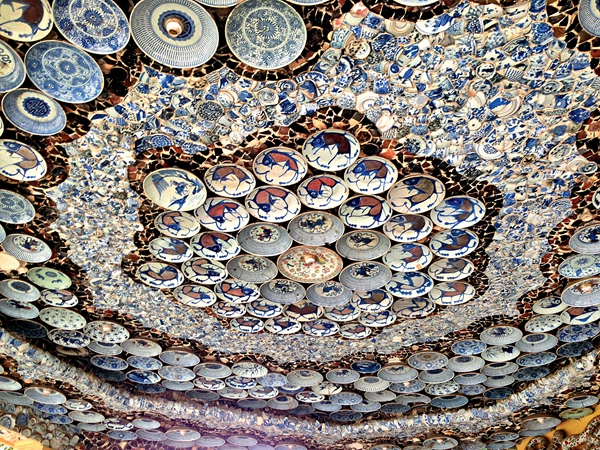All in the Best Possible Taste?
China Today by BRIAN SALTER, April 26, 2017 Adjust font size:
Shock at First Sight
An estimated 5,000 ancient vases, 4,000 plates, and 400 million porcelain fragments adorn the building’s exterior. No one could dispute its epithet, “the most eye-catching building in Tianjin.” Since opening to the public in September 2007, it has of course become one of the city’s most popular tourist attractions.
The courtyard wall is embedded with around 3,000 porcelain vases. The “peace” wall in front of the museum consists of 635 vases made during the late Qing Dynasty, and the Republic of China period (1911-1949).
|
One of the museum ceilings. |
In some ways the place is reminiscent of certain famous Gaudi buildings that grace Barcelona – guaranteed to shock at first glance but which soon enchant the beholder. The house itself is decorated with some 400 million fragments of ancient porcelain, 16,000 pieces of ancient chinaware, 300 white-marble carvings, 20 tons of crystal and agate, and millions of ancient Chinese ceramic chips. Some of the vases and fragments are from as long ago as the Tang Dynasty (618-907).
In fact, about 80 percent of the porcelain embellishing the building is from broken or damaged antiques. Zhang mixed the various fragments and pasted them on the walls in such a way as to conceal their damaged parts. Consequently most of them appear to be intact.
Zhang ensured that elements of Chinese “culture” took center stage in the museum’s exterior décor. He took particular care to feature several groups of entwined dragons on the exterior wall, each one more than 200 meters long and pieced together from thousands of porcelain pieces. Dragons are believed to symbolize the power of ancient China, and are a dominant feature of Chinese architecture.
Everyone snaps away on their mobile phones and takes striking selfies like there was no tomorrow. The museum interior, however, is dim. This impedes full appreciation of the inventive use of a broken teacup.
The museum also contains an abundance of antique furniture, arranged as if for a junk yard sale. The subdued lighting makes it difficult to discern whether these are good pieces or just junk. My guess would be the latter.
